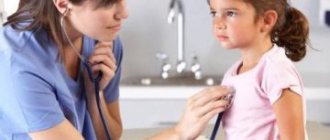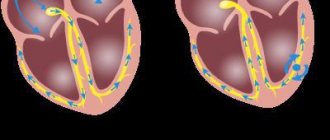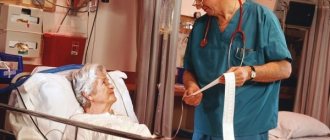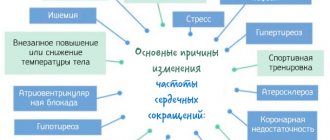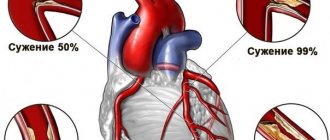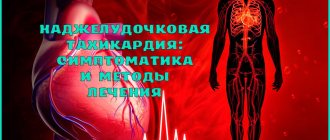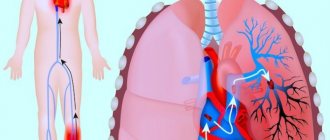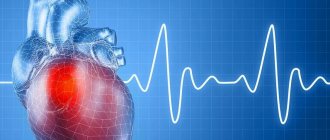Features of the pathology
With supraventricular arrhythmia, a rhythm disturbance is observed directly in the atria.
Supraventricular (supraventricular) arrhythmia develops in the atria, i.e. above the ventricles of the heart. There are several types of supraventricular arrhythmia:
- supraventricular extrasystole;
- tachycardia;
- atrial flutter.
Extrasystole is a premature contraction of the heart caused by impulses from the atria. According to ICD-10 it is designated as I49. This disorder occurs very often, but in most cases it does not threaten health if detected and treated in a timely manner.
Supraventricular tachycardia (code I47.1) is a paroxysmal increase in heart rate above 90 beats per minute. As a rule, during an attack the heart rate reaches 180 beats at rest.
Atrial flutter is a deterioration in the contractility of atrial fibers, manifested by a sudden increase in heart rate up to 200 beats per minute. This pathology is dangerous and requires timely diagnosis and treatment.
There are many reasons for the development of the disorder. Supraventricular arrhythmia can have a functional or organic origin. In the first case, the reasons are:
- autonomic disorders;
- hormonal imbalance;
- caffeine abuse;
- systematic lack of sleep;
- excess weight;
- alcohol abuse.
All these factors lead to dysfunction of the entire heart as a whole and negatively affect the overall functioning of the cardiovascular and nervous systems.
Pregnant women and teenagers often encounter this disorder. The reason is hormonal changes in the body, which entails a temporary disruption of the autonomic nervous system. In adolescents, such a disorder often accompanies vegetative-vascular dystonia.
Organic pathologies against which supraventricular arrhythmia may develop include:
- heart defects;
- myocarditis;
- tumor neoplasms;
- arterial hypertension;
- pulmonary hypertension.
Supraventricular extrasystole is characterized by atrial flutter, out of step with the general rhythm of the muscular organ. Incomplete contractions occur under the influence of premature impulses of extracardiac origin.
The presence of pathology can be suspected only by indirect signs, such as the appearance of shortness of breath, a feeling of lack of air. But it is impossible to make an accurate diagnosis without a full examination. In healthy people, this type of arrhythmia is recorded mainly in childhood and adolescence.
Important! In order to prevent the development of life-threatening complications, patients with an established diagnosis should be registered with a cardiologist at their place of residence.
If treatment is not started in a timely manner, supraventricular extrasystole can lead to heart failure, changes in the shape of the heart chambers and other serious complications.
The rhythm of the heartbeat is set by the sinus node, which is located in the right atrium. The pacemaker distributes impulses through the conduction system. Its fibers branch and are distributed along the walls of the heart.
The case when the impulse that stimulates the heartbeat originates outside the conduction system and causes an extraordinary contraction of the heart is called extrasystole. Palpitations caused by such impulses occur with inadequate contraction of the heart.
The phenomenon of extrasystoles itself may or may not be dangerous for the general condition only in the context of the disease that initiated it. It is important how much the myocardium performs its functions, whether there are organic lesions of the heart.
In a child, supraventricular extrasystole often does not give any symptoms and proceeds unnoticed. With this diagnosis, the sensation of interruptions in the heartbeat begins to appear in adolescence.
Do not confuse supraventricular and ventricular extrasystoles, these are different conditions. There are also frequent cases of confusion between supraventricular tachycardia and ventricular extrasystole.
We will talk about what single and paired, rare and frequent supraventricular extrasystole is in the next chapter.
Sinus arrhythmia: symptoms and causes
Even when the heart muscle is in a healthy state, its contractions are not always constant.
Experts explain this feature by the fact that the sinoatrial node is influenced by various parts of the nervous system, which are an important part of the conduction system of the heart, ensuring the coordinated work of other participants in cardiac activity.
When the changes that occur exceed the threshold of 10%, experts declare disturbances in the heart rhythm. On the other hand, if the main motor of the human body works without failures and its contraction frequency does not change, then this indicates that the heart is exhausted and there is heart failure, there are signs of coronary artery disease.
Quite often, during the period of rapid development of adolescents, sinus tachycardia is detected during examination. This condition also occurs during the formation of the nervous system. In some cases, sinus arrhythmia that occurs in a person indicates disturbances in the blood circulation and indicates a disease of the brain or a disease of the nervous system.
Doubling the number of contractions during inhalation compared to exhalation is the main symptom of this pathology. Typically, the pulse of a person experiencing sinus arrhythmia is at rest at 80 beats per minute. If sinus bradyarrhythmia occurs, the heart rate is fixed at 60 beats per minute. Often the onset of this condition occurs after the cessation of intense sports activities. This pathology is expressed by the occurrence of symptoms such as weakness, rapid fatigue, as well as pain appearing in the chest and shortness of breath.
From time to time, a person who has encountered such a pathology becomes dizzy. To normalize the condition, the patient is prescribed sedative therapy based on herbal preparations. For this type of cardiac arrhythmia, special treatment is not required.
Clinical picture
The feeling of palpitations or the heart turning over in the chest may be one of the symptoms of supraventricular arrhythmia
The severity of symptoms depends on the severity of the pathological process. For example, with single extrasystoles the patient does not feel discomfort. With multiple and frequent rhythm disturbances, supraventricular arrhythmia will manifest itself with the following symptoms:
- a feeling of interruptions in the work of the heart;
- shortness of breath and a feeling of being unable to take a deep breath;
- dizziness and weakness;
- flush of heat to the face;
- increased sweating.
This arrhythmia is paroxysmal in nature. An attack can last from a few seconds to a couple of minutes, no longer. At this time, the frequency and rhythm of heart contractions change. As a rule, the onset of an attack is noted against the background of intense physical or psycho-emotional stress.
Characteristic symptoms of supraventricular extrasystole:
- discomfort in the chest area, the patient feels that the heart rhythms are interrupted;
- dizziness, sometimes nausea and vomiting;
- feeling of weakness;
- shortness of breath, difficulty breathing.
Advice! A characteristic symptom of the disease is a change in the psychological state of the patient. Most patients experience a feeling of fear and anxiety for their lives.
Complications
Various complications often develop against the background of arrhythmia. It could be:
- heart failure;
- changes in the size and shape of the heart chambers caused by extrasystoles.
Symptoms
Symptoms of extrasystole, regardless of the causes of the disease, are not always pronounced. Most often, patients complain of:
- Malfunctions of the heart (you may feel as if the heart is turning over in the chest);
- Weakness, discomfort;
- Increased sweating;
- Hot flashes;
- Lack of air;
- Irritability, feelings of fear and anxiety;
- Dizziness. Frequent extrasystoles may be accompanied by dizziness. This occurs due to a decrease in the volume of blood ejected by the heart muscle and, as a result, oxygen starvation in the brain cells.
Extrasystole may be a sign of other diseases. For example, extrasystole in vegetative-vascular dystonia (VSD) is caused by a violation of the autonomic regulation of the heart muscle, increased activity of the parasympathetic nervous system, and therefore can occur both during physical exertion and in a calm state. It is accompanied precisely by symptoms of a nervous system disorder, that is, anxiety, fear, irritability.
The extrasystole that occurs with osteochondrosis is due to the fact that, during the disease, compression of the nerve endings and blood vessels occurs between the vertebral discs.
In pregnant women, the appearance of extrasystoles is also quite often recorded. Usually, extrasystoles during pregnancy occur due to fatigue or anemia, as well as if the woman had problems with the thyroid gland, cardiovascular and bronchopulmonary systems. If the pregnant woman feels well and has no complaints, then no treatment is required.
Extrasystole after eating is also not uncommon. It is functional and usually does not require treatment. This extrasystole is associated with the parasympathetic nervous system and occurs if a person, after eating food, takes a horizontal position. After eating, the heart rate decreases, and the heart begins to turn on its compensatory capabilities. This happens precisely due to extra, extraordinary heart beats.
Classification
Localization of outbreaks
The places where the impulse is generated during supraventricular extrasystole are called ectopic foci. According to their localization, pathology is divided into types:
- atrioventricular extrasystole - impulses that cause extraordinary contractions have their foci in the septum that separates the ventricles and atria;
- atrial extrasystole - foci with impulses formed in the atria.
DETAILS: Treatment of arrhythmia with laser - All about hypertension
The manifestation of extraordinary impulses can occur in accordance with some pattern or chaotically. On this basis they distinguish:
- Allorhythms - a normal contraction alternates with a certain number of extrasystoles (for example: one, two or three), that is, a rhythmic pattern is observed.
- Disordered - extraordinary contractions occur in relation to normal contractions in a voluntary manner.
Depending on the number of ectopic foci, the disease is classified into options:
- polytopic supraventricular extrasystole – in a patient several foci induce impulses outside the conduction system;
- monotopic extrasystole - extraordinary contractions are initiated by one focus.
Frequency
According to frequency they are distinguished:
- group - if several extrasystoles pass in a row between normal rhythms,
- paired - among normal contractions there are extraordinary ones, two in a row;
- multiple - this means cases when there are more than five extraordinary contractions of the heart per minute;
- single supraventricular extrasystoles - less than five extrasystoles occur per minute.
Time of occurrence
Extrasystoles are divided according to the time of their occurrence:
- late - appear simultaneously with contraction of the ventricles;
- interpolated - appear at the moment between contractions of the ventricles and atria;
- early - appear simultaneously with atrial contractions.
In the first case, rhythm disturbances occur at the moment of contraction of the upper sections, in the second - at the border of the moment of contraction of the upper and lower sections. With late extrasystole, disturbances occur during the period of ventricular contraction or in the resting phase.
Advice! In medicine, the site of excitation or ectopic focus is the area in which additional impulses are formed that cause contraction of the heart muscle.
Based on the location of the ectopic focus, the following are distinguished:
- atrial extrasystole – when located in the atrium;
- atriventricular arrhythmia - when the focus is located in the lower section, namely in the septum separating the ventricles and atria
Based on the frequency of occurrence, the following forms are distinguished:
- single (less than five non-rhythmic contractions (extrasystoles) per minute;
- paired (two extraordinary contractions between normal ones);
- multiple (more than 5 irregular contractions per minute);
- group (more than two extrasystoles in the interval between normal contractions.).
By nature, disordered and ordered arrhythmias are distinguished. The former are characterized by the absence of a system between normal and additional contractions. In the second, a certain number of additional contractions are noted between normal contractions.
What will happen without treatment?
Supraventricular arrhythmia with multiple attacks is dangerous for the development of heart failure. Severe complications include coronary and cerebral circulation disorders. This may lead to the development of other cardiovascular diseases, as well as neurological disorders caused by cerebrovascular insufficiency.
With severe arrhythmia, the patient’s quality of life deteriorates significantly. First of all, there is a deterioration in exercise tolerance. Due to poor circulation, patients complain of frequent migraines and fatigue.
Supraventricular arrhythmia, which is not typical for healthy individuals, is a disorder that is characterized by progression. Only a doctor can make an accurate diagnosis, so it is recommended not to delay a visit to a cardiologist.
Development factors, signs and treatment of supraventricular arrhythmia (extrasystole)
Heart disease is the scourge of modern medicine. According to statistics, every third person on the planet is susceptible to all sorts of abnormalities in the functioning of this vital organ, be it rhythm disturbances, sclerosis, myocarditis and many others.
Supraventricular extrasystole is one of the types of arrhythmia that manifests itself in the upper parts of the heart or between the atrium and ventricles, and represents uncharacteristic, extraordinary, defective contractions.
- sensation of extraordinary heart beats;
- “revolution” of the heart;
- dizziness, weakness;
- dyspnea;
- attacks of panic and fear associated with a feeling of premature death;
- insomnia.
As a rule, after the manifestation of such symptoms, many people go to the clinic and try to establish the cause of this condition.
A cardiologist will be able to diagnose the disease based on complaints, examination of the patient and some tests. The specialist listens to the heart rhythm, compares the number of heartbeats with the patient’s pulse, and performs percussion in the area of the heart (tapping the boundaries).
- EchoCG – ultrasound of the heart.
- ECG – electrocardiography.
- ECG with stress - allows you to track heart rhythm disturbances during and after physical activity. As exercise, the patient is asked to do several squats, run on a treadmill, or ride an exercise bike.
- 24-hour heart rate monitoring using Holter.
- General and biochemical (detailed) analysis of blood and urine.
- Hormonal status.
If the patient had relatives suffering from arrhythmia, then the chances of confirming the diagnosis of supraventricular extrasystole increase several times.
An unhealthy lifestyle and excessive physical activity can provoke single extrasystoles; according to statistics, they are observed in 75% of absolutely healthy people; this is the most common type of arrhythmia.
Although the manifestation of single extrasystoles has not been fully studied and causes a lot of controversy among cardiologists. And yet, if they become more frequent, a feeling of “failure” in the heart and rapid fatigue haunts you more and more often, consult a doctor.
Cardiac extrasystole is one of the types of arrhythmia, which results in additional contraction of the heart muscle. At the same time, the heart or a certain part of it contracts. Patients suffering from a similar phenomenon feel unusual discomfort in the heart area, a freezing of the heartbeat itself. Some describe this condition as strange beats coming from inside the chest.
All these are signs of the most common heart disease associated with irregular heartbeat rhythms. The symptoms that appear indicate that the person needs mandatory antiarrhythmic therapy and constant medical supervision.
DETAILS: The dangers of blood transfusion
Supraventricular extrasystole is one of the types of heartbeat rhythm disturbances, which is most often accompanied by tachycardia or bradycardia.
The main symptoms of the disease are not always pronounced. More often you hear complaints that, at first glance, have nothing to do with diseases of the cardiovascular system.
Typically complaints are of the following nature:
- 1. A surge of weakness, a feeling of discomfort.
- 2. Sweating increases, which is accompanied by hot flashes.
- 3. Clear lack of air.
- 4. Psychological changes. The person becomes more irritable. His mood is constantly changing. There is fear, an anxious feeling and the expectation of something bad. The feeling of anxiety increases.
In this case, extrasystoles are accompanied by dizziness. Dizziness is a clear sign that the volume of blood released as a result of contraction of the heart muscle is decreasing. As a result, oxygen starvation occurs and, as a result, the brain suffers.
Supraventricular arrhythmia is characterized by a certain type of heart contraction, in which premature impulses occur - the upper parts are activated out of turn. Another name for the pathology is supraventricular extrasystole. The disease develops against the background of pathological disorders. It is also observed in completely healthy people.
Heart rhythm disturbances caused by extraordinary contractions occur in healthy people. When the reasons for this phenomenon are not identified, they speak of idiopathic extrasystole.
Some factors can provoke this kind of arrhythmia:
- diseases associated with endocrine disorders: dysfunction of the adrenal glands,
- malfunction of the thyroid gland,
- diabetes;
- diuretics,
Prevention, complications, prognosis
Lifestyle correction is the basis for disease prevention; it is necessary to:
- stop smoking and drinking alcoholic beverages;
- eat right, don’t overeat;
- prevent obesity;
- get enough sleep (full night's sleep);
- adhere to a rest and wakefulness regime;
- engage in only feasible sports;
- exclude heavy physical activity;
- avoid psycho-emotional experiences;
- treat any diseases in a timely manner;
- Take medications only as recommended by your doctor.
Patients at risk should undergo regular preventive examinations. Regardless of the course of the disease, patients need to be monitored by a cardiologist at least 2 times a year.
A single supraventricular extrasystole does not pose a threat to health. The quality of life does not change. Constantly recurring attacks can lead to the development of other, more life-threatening arrhythmias (for example, atrial fibrillation). They can cause cardiac ischemia, heart failure, and pathological changes in the atria. In general, if you follow the doctor's recommendations, the prognosis is favorable.
Supraventricular extrasystole is a violation of the heart rhythm and, as a rule, does not threaten human life. But if it is combined with other heart diseases, the consequences can be serious. It is necessary to consult a doctor as soon as possible and begin treatment. The problem can occur to varying degrees in healthy people.
Principles of treatment
Before starting treatment, you should remember one rule: supraventricular arrhythmias are the norm for every person if they occur against the background of certain stressful situations or heavy loads. Athletes often experience temporary heart rhythm disturbances.
In the case where the doctor has identified a supraventricular arrhythmia in the patient, which is not typical for healthy individuals, treatment is carried out. Treatment of supraventricular arrhythmia includes drug and non-drug methods.
Drug therapy is based on taking drugs from the following groups:
- beta blockers;
- calcium antagonists (calcium channel blockers);
- class 1 antiarrhythmic drugs;
- sedatives.
The decision to prescribe sedative medications is made by the doctor. As a rule, the stress factor plays a minor role in the development of this type of arrhythmia. However, if supraventricular arrhythmia develops against the background of autonomic dysfunction, the patient may be prescribed herbal sedatives, for example, Persen, or hawthorn tincture.
Non-drug treatment comes down to the following rules:
- normalization of the daily routine;
- normalization of sleep;
- balanced diet;
- quitting smoking and alcohol;
- avoidance of caffeinated drinks;
- moderate physical activity;
- regular walking.
Walking in the fresh air is recommended before bedtime. This will help relax the nervous system and improve the quality of sleep.
A person should learn to deal with stress. For this purpose, it is recommended to devote 1-2 hours of rest every day, distracted from work, and also to master breathing exercises. Yoga, swimming in the pool, and cycling are beneficial for the health of the heart and nervous system.
In addition, recent studies have proven that regular jogging reduces the risk of developing cardiovascular diseases by half and increases the overall endurance of the body. However, you should consult with your doctor about which physical activities will not cause harm and are allowed for this type of arrhythmia.
The limitation is due to the fact that supraventricular arrhythmia can be expressed by different intensities of symptoms. If the ECG reveals minor deviations from the norm, sports will definitely benefit the person, however, in case of severe violations, intense exercise is prohibited.
Diagnosis of the disease
Heart health responds very well to activities that support a healthy lifestyle.
You should review your daily routine and habits and introduce rules:
- Avoid excessive physical activity and other types of overload,
- maintain a cheerful positive emotional background.
- Eat foods that are good for your heart, exclude: fried foods,
- spicy and canned food,
- fatty foods,
- containing harmful additives.
- potassium,
DETAILS: Why is sinus tachycardia dangerous in a teenager?
It is useful for the patient to reconsider his mental attitude, work on himself and abandon the thoughts and attitudes that feed and even create this disease.
Before studying methods of diagnosis and treatment, you need to understand what ventricular and supraventricular arrhythmias are in principle:
- Arrhythmia (extrasystole) is a pathology that affects the process of contraction of the heart muscle. At the same time, the frequency of contractions, their rhythm, strength, etc. change, which leads to disruption of the blood supply to individual organs and the body as a whole.
- With ventricular arrhythmia, conduction impulses are localized below the Hiss bundle, in the region of the ventricle.
- With supraventricular arrhythmia, the pathology is localized in the atrium. Atrial extrasystole does not directly affect the blood supply to the heart and can be localized in one or several foci.
The most common heart rhythm disorder is supraventricular arrhythmia.
A more complete answer to the question: “Supraventricular arrhythmia - what is it?” will help to answer the analysis of the reasons causing this pathology.
Other reasons include:
- the use of excessive amounts of diuretics or incompatible drugs in the treatment of various diseases;
- hormonal pathologies (often associated with disorders of the thyroid gland);
- metabolic disorders;
- taking medications that stimulate the heart muscle;
- taking stimulants;
- diseases of the cardiovascular system (myocardial infarction, coronary heart disease, atherosclerosis, developmental defects).
Sometimes supraventricular arrhythmias of the heart are observed during intoxication with low-quality alcohol. And in general, with the abuse of alcoholic beverages and regular smoking, atrial extrasystole can occur even in healthy people who are not predisposed to such a disease.
Pathological disturbances in the functioning of the cardiac system increase the risk of developing supraventricular arrhythmia
Symptoms of arrhythmia
With supraventricular arrhythmia, the clinical picture usually includes the following symptoms:
- pain in the chest area, manifested in the form of unexpected short-term attacks;
- lack of air (difficulty in inhaling when the oxygen content in the atmosphere is normal);
- headache, nausea;
- decreased efficiency of the heart muscle.
As a rule, all this negatively affects a person’s physical condition. Against the background of insufficient oxygen supply to organs and tissues, fatigue increases and performance (both physical and mental) decreases.
With this heart disease, special attention must be paid to diagnosis. Supraventricular arrhythmia has several categories, each of which differs in the nature of the disease and its effect on the functioning of the heart muscle.
A single type of arrhythmia in itself has virtually no negative impact. However, over time it can develop into a more serious form, which will cause the development of cardiac tachycardia, myocardial infarction or atrial fibrillation.
Extrasystole or arrhythmia is a disturbance of the heart rhythm. This process can be characterized not only by uncomfortable and unpleasant sensations in the chest area, but also periodically severe chest pain may occur.
If pain occurs, it is necessary to begin a course of treatment prescribed by the attending physician. Self-medication in this situation will not only not bring positive results, but may even worsen the situation.
Experts cannot guarantee accurate predictions, since the patient’s further condition depends on his lifestyle, whether he follows all the doctor’s recommendations, and also on the presence of concomitant heart diseases.
In order not to have any problems in the future associated with the activity of the heart, it is best to carry out preventive measures that are aimed at preventing the occurrence of arrhythmia of any type. The main thing is to find out the factors that can trigger the appearance of supraventricular arrhythmia. This may include lack of rest, poor diet, and bad habits. Therefore, it is worth reducing the impact of all these negative factors on your body. Then in the future there will be no problems associated with arrhythmia.
Causes
Supraventricular arrhythmia is characterized by causal groups of occurrence.
Pathologies of the cardiovascular system:
- ischemic diseases;
- lack of functionality of the cardiovascular system;
- damage to the heart muscles;
- congenital or acquired defects;
- inflammatory diseases - myocarditis, etc.
Intoxication factors:
- smoking and alcohol abuse;
- work in toxic industrial enterprises;
- uncontrolled use of certain groups of drugs or their overdose - diuretics, antiarrhythmic group, glycoside series.
Other pathological causes:
- chronic diseases;
- disorders in the endocrine system - diabetes mellitus, thyrotoxicosis, etc.;
- hypoxia, anemia, apnea;
- diseases of the respiratory system.
Supraventricular arrhythmia can also occur without cause. This form is called idiopathic.
